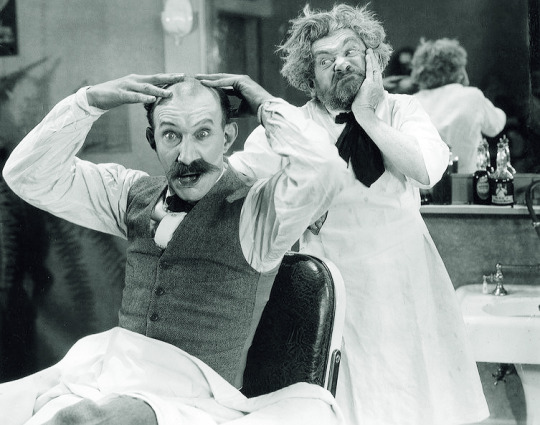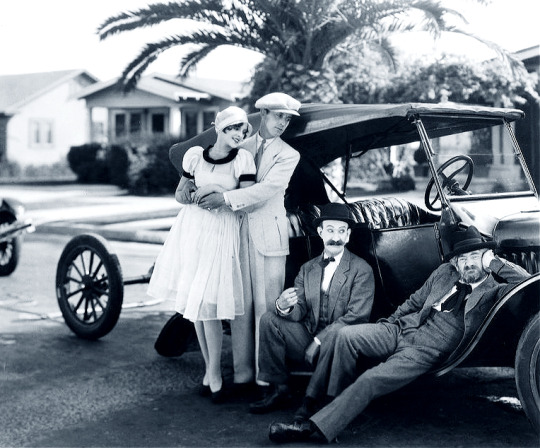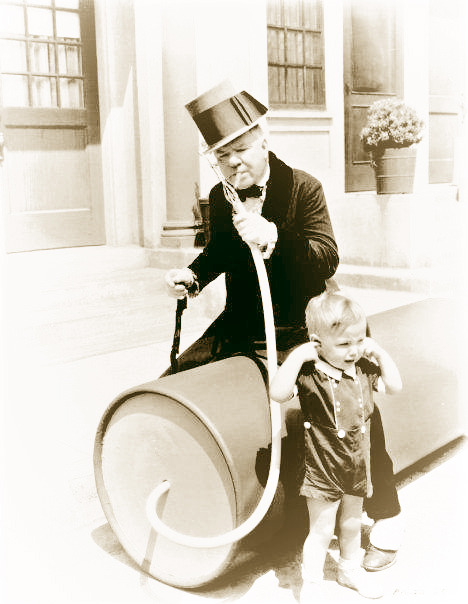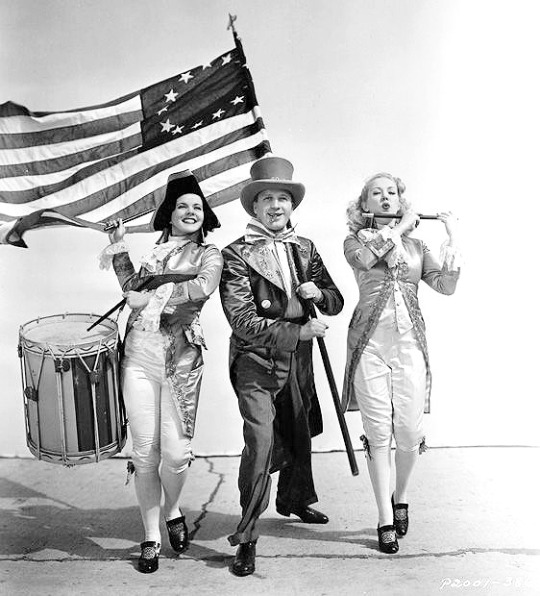Da Trixsta on tumblr! Classic Comedy Nerd/78 RPM record restorations/old movie & cartoon music....
Last active 3 hours ago
Don't wanna be here? Send us removal request.
Photo

“Fighting Fathers” is a long lost 1927 Hal Roach produced Max Davidson comedy short written by Leo McCarey. Seen are principle cast members (left to right): Unknown, James Finlayson, Max Davidson & Martha Sleeper.

“Doh–!” James Finlayson reacts with surprise while Max Davidson seems to emote his traditional comic take of “Oy vey–!” which is a Yiddish phrase expressing dismay or exasperation. (Finlayson seems to have had a hairline in the previous photo.)


Far from the perfect day…
No known prints of this film are known to exist.
#max davidson#james finlayson#martha sleeper#hal roach studios#leo mccarey#classic comedy#two reel short#short film#selected short subject#1920s#roaring 20s#flappers#fathers in law#barber shop comedy#1927 film#silent comedy#silent film#lost film#fighting fathers
17 notes
·
View notes
Photo

W.C. Fields & Baby LeRoy probably taken during production of “The Old Fashioned Way” (1934)
14 notes
·
View notes
Photo

Paramount publicity photo showing Zoe Dell Lantis in 1938 with Jack Benny & Betty Grable. Zoe Dell Lantis passed away on April 22, 2020 at the age of 104.
40 notes
·
View notes
Audio

Song: “It’s All The Same to Me” Performed by: Cliff Edwards
Composers: Roy Turk, Harry Akst & Cliff Edwards
Pathe’ Record: 32090-B matrix # 105668=Take 02
Recorded: November 11, 1924
#songs of contempt#cliff edwards#ukelele ike#ukulele#roaring twenties#1924 song#78 rpm#my transfer#1920s#Popular song#songs of spite#scat#effin#Pathe
35 notes
·
View notes
Photo

Issue No 42; more like Issue 420…
6 notes
·
View notes
Photo

Rare 1940’s color image of Arthur Lake & Penny Singleton in character as “Dagwood & Blondie”. Few actors embraced their screen roles as whole-heatedly as Lake & Singleton did. This photo was posed in Penny Singleton’s own home kitchen! The tomatoes may have been grown on her own farm as well. I have to wonder if Robert Sparks may have taken this photo. (Singleton’s husband Robert Sparks produced 12 of the 28 Blondie films.)
Many of the actors on the Blondie radio show also noted Lake’s commitment to the program, stating that on the day of the broadcast, Lake “was Dagwood Bumstead.”
Far from being upset about being typecast, Lake continued to embrace the role of Dagwood in a short-lived 1957 Blondie TV series, then even into the 1960s and beyond; he often gave speeches to Rotary clubs & other civic organizations, eagerly posing for pictures with a “Dagwood” sandwich.
#dagwood and blondie#blondie#arthur lake#penny singleton#robert sparks#Columbia Pictures#comic strips in film#film franchise#1940s hollywood#1940s film#wartime#comedy series#blondie & dagwood#dagwood#things you are used to seeing as black & white in color#color photography
29 notes
·
View notes
Video
April Foolishness!
Performance: George Formby
“The Barmaid at The Rose & Crown”
Music director: Harry Bidgood
from Columbia Pictures “South American George” Released to theatres: December 27, 1941
#april fools#george formby#classic comedy#south american george#talkies#British comedy#1940s movies#wartime film#banjolele#ukulele#banjo#turned out nice again
10 notes
·
View notes
Video
A bit of April foolishness … with Olsen & Johnson Back in 1978 Walter Matthau hosted a retrospective of classic comedy films called “Funny Business” & in it, he said; “Chick Johnson & Ole Olsen succeeded not by being good; but by being terrible… and admitting it.” That having been said; they made several films in the 1930’s & 40’s. They also appeared on network radio & early television, but their greatest success may have been their Broadway stage reviews like “Hellzapoppin’”….which they made a crazy movie version in 1941. The film is fourth-wall breaking & full of the surreal humor that would later be commonplace in comedy films like “Airplane” & “Blazing Saddles”. This clip was from 1943′s “Crazy House”.
#olsen and johnson#comedy teams#chick johnson#ole olsen#crazy house#1940s movies#1943 film#old hollywood#sherlock holmes#classic comedy#basil rathbone#nigel bruce#leo carrillo
20 notes
·
View notes
Audio
For Saint Paddy’s Day & for my friend, O'Brien—
Here is a comic song with an Irish surname in the title & I guess it was a trend around that time with George M.Cohan’s “Harrigan” & “Has Anyone Here Seen K-E-L-L-Y?” among others.
Both of these Victor records are performed by the team of Arthur Collins & Byron G. Harlan, who were a popular duo on records & cylinders right through the first World War.
“O'Brien” was recorded in 1903 & has been in my collection since 1983…. So I guess it was pretty old even then… I knew it had to be, as the earliest records were one-sided & this was….
The comic misadventures also give you an idea of how all people in cities used street cars at some time or another~! They sound like drunks yelling more than singing, but in those days you had to be loud to be picked up by the recording horn…
“Oh-Oh-O'Brien!” Collins and Harlan, performing (recorded in Philadelphia, possibly) Victor 1966 Matrix/Take: [Single-Sided;Pre-matrix B-]1966 / take M-2 1903-02-12
————————————————-
4 notes
·
View notes
Video
It has been said: “If You Can Dance; You’re in with a chance”– Well, Here is Hal Le Roy when he was about 17. This is the same year his dance style created a sensation in The Ziegfeld Follies. Le Roy’s style was very much along the lines of Al “Rubber Legs” Norman, as evidenced elsewhere in this short film…. a sort of “High School Musical” otherwise short on talent.
#hal le roy#Dinah#eccentric dance#Tap dance#hoofer#Broadway#Ziegfeld Follies#talkies#1930s film#hal leroy#1931 film#selected short subjects#variety stage#vaudeville#dance#dancers#dance music#choreography#dancing
45 notes
·
View notes
Photo

Happy Valentines’ Day From Our Gang kids (Left to Right): Dickie Moore, Matthew ’‘Stymie’’ Beard , George ’'Spanky’’ McFarland, Pete the Pup, Dorothy DeBorba, Tommy “Butch” Bond & Tommy “Remarkable” McFarland.

30 notes
·
View notes
Audio
I’m Popeye The Sailor Man (1935/04/27) William “Billy” Costello (Red Pepper Sam) Melotone (Brunswick Records) #17393 Matrix M-13402 ============================================ With the coming of sound film, Sammy Lerner began writing songs for motion pictures, including several for use in the Paramount Pictures cartoons produced by Fleischer Studios. Two of these included signature songs for Max Fleischer’s most successful cartoon stars, Betty Boop (“Don’t Take My Boop-oop-a-doop Away”, co-written with Sammy Timberg) & Popeye the Sailor (“I’m Popeye the Sailor Man”). Mr. Lerner composed “I’m Popeye the Sailor Man” in less than two hours for the cartoonist Dave Fleischer. The lyrics included the line, “I’m strong to the fin-ich/‘cause I eats me spinach–”. Initially, he wasn’t proud of it. Lerner’s Popeye theme is particularly well known, & has followed the character into radio, records, television, feature films, & video games. After 50 years, Mr. Lerner gladly took credit for his little sailor’s ditty that had gone-global long before there was ever such a thing as a twitter feed!
This record is an example of the type of milage William “Billy” Costello would get out of his post-Popeye persona. Olive Oyl is heard on this record too, but sounds like she hasn’t been taking her estrogen….
#popeye the sailor#william costello#red pepper sam#billy uke carpenter#max & dave fleischer#1930s movies#vintage records#vintage animation#78rpm record#Popeye#classic cartoons#sammy lerner#sammy timberg#paramount pictures#i'm popeye the sailor man
25 notes
·
View notes
Audio
Nobody’s Sweetheart Now (1934)
Billy “Popeye” Costello (Titan Co.Transcription Disc) ============================================ Who was dat scat-man?
Recalling William “Billy” Costello (02/02/1898 – 10/09/1971)
Billy Costello vs. Billy “Uke” Carpenter (Were They One-In-The Same?) ============================================ For years, the odd effin’ scat vocal that was heard in 1932’s “Betty Boop M.D.” is sometimes erroneously credited to Cliff Edwards, But I never did think it was him. I had collected old recordings of Cliff ever since I was a kid & heard him on the Dumbo soundtrack album.I had no reference of who he was until someone had told me that was “Ukulele Ike”. So, who was that scatting in the “Betty Boop M.D.” cartoon? Sounds alot like Cliff Edwards, even though the singing voice didn’t! I have spent a lot of time listening to this performance, as back in the days before home video, I always had a tape recorder & one Saturday I caught, “Betty Boop M.D.” on public television & with cassette recorder in hand, I bootlegged the audio right off the television! The cartoon was weird & wonderful, but I had seen Betty Boop shorts before & they were sometimes like that.The part of Bimbo stole the show here, going into this odd gurgling style of singing that sounded so much like Ukulele Ike to me, but— not really.
It was also around this time I got my hands on Leonard Maltin’s book, “Of Mice & Magic; A History Of American Animated Cartoons”. In it, Maltin had interviewed Mae Questel. Mae recalled the actor who originally gave Popeye his first onscreen voice; William Costello. Costello had already been working with the Fleischer Studio as the voice of Gus the Gorilla on the Betty Boop radio show & they felt that the funny raspy voice he had used for that character would work for the new Popeye character they were planning. He was cast to provide the voice for the very first Popeye cartoon, 1933’s “Popeye the Sailor”. Popeye on the screen was a hit!

In vaudeville, “Billy” Costello had been known as “Red Pepper Sam” & Costello may have been a victim of his own success, as Mae Questel recalled he only had the role for about a year before “success went to his head so fast it was ridiculous.” Now, that lends color to what I had heard when I was researching the Fleischer Popeye Cartoons previously. “That guy”(Costello) was demanding more money as the Popeye franchise had became a hot property for Paramount Pictures. Cartoon producer Max Fleischer knew a thing or two about actors & voices, as he had just came out of a lengthy court case vindicated over the whole Helen Kane vs. Betty Boop imbroglio! Have you heard about that? ============================================ Historic Aside: In May 1932, it seems Helen Kane had filed a $250,000 lawsuit against Paramount & Max Fleischer, charging “unfair competition & wrongful appropriation” in the Betty Boop cartoons. The trial opened that year with Helen Kane & Betty Boop films being viewed only by the judge. No jury was called. Voice Actors Bonnie Poe, Kate Wright, Margie Hines, & most notably Mae Questel were all summoned to testify. Vamping it up for the Paramount newsreel cameras & Boop-a-doop-ing as if their lifestyles (& livelihoods) depended on it, Mae Questel led the gals in a chorus of “Please Don’t Take My Boop-oop-a-doop Away”! “Uncle Max” couldn’t have planned it better, had he animated this all as a cartoon!
The general conclusion was based upon the idea that there is nothing unique about one particular voice that was/is similar to hundreds of others; but in truth the case may have done more to hurt Helen Kane’s career as the case dragged on for more than two years before the judge ruled against Kane, further claiming her testimony did not prove that her singing style was unique & not an imitation itself; especially since an African American singer known as “Baby Esther” had been cited by the defense as “boop-ing” in song, even earlier! This according to wikipedia: Theatrical manager Lou Walton testified for the defense stating that in 1925, he coached a “young negro child” named Esther, teaching her how to interpolate her songs with scat lyrics, which she later re-purposed into her trademark “boop oop a doop”. Jones’ manager testified that he & Kane had seen her act together in April 1928, and just a few weeks later, Kane began to “boop”! Case dismissed! (gavel slams & fade to black) Closing shots of Max Fleischer & his lady voice actors surrounding him around his desk smiling & singing a reprise chorus of “They couldn’t Take My Boop-oop-a-doop A-way..” (fade-out) ============================================ Now back to my thread about Billy Costello — When we last left Billy, he was holding up “Uncle Max” for more money. Costello’s final appearance as Popeye was in “You Gotta Be a Football Hero” (1935). He had already done about 24 of the Popeye cartoons at this point, some commercial Popeye records, as well as having appeared in a series of “Betty Boop radioland” broadcasts with Mae Questel. It can be assumed Max Fleischer assured him that it was alright; “we can have some else do that voice—” Thus William Costello was fired by the Fleischers, allegedly over “bad behavior,” & was replaced with studio writer Jack Mercer. It was commonly known amongst the animators Jack Mercer could do that Popeye voice, as he had done for the fun & amusement of his fellow co-workers! Perhaps Max was secure in this knowledge, but my guess is the lawsuit had proven to him that there would always be someone else, & as for Costello being a unique talent; sadly that just wasn’t the case. Indeed, anyone who recalls the great Fred Waring Victor recordings of the mid to late 1920’s would have heard a very similar “Popeye” voice in many of their novelty numbers delivered by their long-time drummer Poley McClintock! So, as a collector of 78 records, it first occurred to me years ago, how popular Cliff Edwards must have been to have spawned such a series of imitators! (Not that Edwards had been the very first either, Ukulele Bob Williams may have influenced Edwards; however Edwards was perhaps the most commercially successful of these acts) However, I also strongly suspect Costello dropped the name “Red Pepper Sam” to avoid confusion with Jack Pepper from the duo of “Salt & Pepper”. (Jack Pepper was yet another ukulele player & scat-singer, with a style so similar to Costello & Cliff Edwards, that these acts would soon lose their novelty appeal & fall out in favor of the Bing Crosby school of crooning!)
So I think that’s where the name Billy “Uke” Carpenter comes into play. Fellow record collector & radio historian Rich Conaty is the host of “The Big Broadcast” on WFUV-FM in New York, (Now in its 43rd year!) & he is in agreement with me, that Costello & Carpenter are in fact the same man! For a few years, it would seem Costello would continue making appearances where he could, playing off his former fame as Popeye’s cartoon voice. Costello died in San Jose, California, on October 9, 1971. He was buried in the family’s plot in Mariposa, California. ============================================ Now if you have followed me this far; Thank you. If there was any further doubts about William Costello not being the vocal talent used in “Betty Boop M.D.”, just listen to his performance of “Nobody’s Sweetheart Now”, it is not Cliff Edwards…It’s William Costello…No doubt about it. I have included about 30 seconds of the cartoon soundtrack prior to the record, so one can compare the performances! By the way, The song “Nobody’s Sweetheart Now” was originally introduced as an ironic song of contempt. It’s lyric deals with a former sweetheart turned streetwalker & now that you’re anyone’s you’re really nobody’s— See? It was written in 1924 by Billy Meyers & Elmer Schoebel.
Update: I have since found out the performance heard in “Betty Boop M.D.” (1932) was from a commercial phonograph record the studio had used! Complete with gargle! The sound editors cut out the middle of it, but it was a Romeo record of none other than Red Pepper Sam performing “Nobody’s Sweetheart Now”! He had recorded this song on various labels over the years!
Patrick.
https://clyp.it/zynbw2jg
https://www.youtube.com/watch?v=F4Pib_9Yqik
#betty boop#billy costello#billy uke carpenter#william costello#Popeye#popeye the sailor#red pepper sam#max & dave fleischer#78rpm record#transcription disc#1924 songs#1934 record#billy meyers#elmer schoebel#1930s movies#vintage animation#classic cartoons#Cartoons#oldtime cartoon#max fleischer#mae questel#betty boop md#1932#1932 cartoon
9 notes
·
View notes
Video
A shot of W.C. Fields (1880 - 1946) on the date of his birth-anniversary with an old friend from The Ziegfeld Follies days; Leon Errol (1881 - 1951).
18 notes
·
View notes
Photo




A Heavenly Happy Birthday to “The Boss” — Hal Roach
Harold Eugene Roach Sr. (January 14, 1892 – November 2, 1992) was an American film and television producer, director, and actor from the 1910s to the 1990s, best known today for producing the Laurel & Hardy and Our Gang film comedy series.
I met him when he was 100 years old.

10 notes
·
View notes


